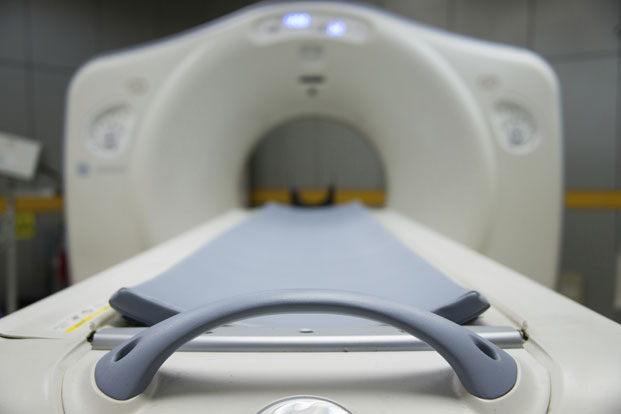Computed tomography scans, or CT scans, are popular and valuable tools for examining nearly any part of the body to detect the presence of tumors or other abnormalities.
CT scans use X-ray beams that rotate around a stationary patient, producing cross-sectional images, or “slices” of the body area being analyzed. Most CT scans are conducted when checking the cause of a patient’s symptoms or to confirm or rule out a suspected illness. However, CT can also be used as a screening tool, detecting disease at an early stage before it produces symptoms and while it remains limited enough to be effectively treated.
While CT can be used as a tool for early detection of cancers and other illnesses, there are also risks for false positives in healthy patients, leading to costly follow-up testing or even unnecessary surgical procedures.
In recent years, the idea of using a whole-body CT scan (WBCT) as a non-targeted screening tool has been gaining in popularity among the public and with some radiologists. This tool was first made popular by an early 2000 Wall Street Journal article which reported on the efforts of several radiologists who were seeking to make CT part of preventative medicine programs. Since then, the media has publicized the emergence of new facilities for whole-body CT screenings and advertising their life-saving potential as screening tools.
Hard numbers are not available, but industry reports have claimed that the use of whole-body CT scans have doubled or possibly tripled in the past five years. Those with the resources to afford the costly test have accepted the benefits of such a screening tool, seeking the reassurance that comes from a normal scan. Experts, however, are divided on the value of this test, which can cost upwards of $1,000 or more in some cases.
As you weigh the possibility of a whole-body CT scan, consider the pros and cons outlined by experts below:
The Pros
Supporters of whole-body CT scan claim that the screening tool offers patients the ability to detect diseases, such as certain forms of cancer, early enough to improve prognosis and work towards a much easier treatment plan. Among the other benefits claimed by supporters:
Improving Scanning for Symptomatic Patients
A whole-body CT scan can reduce the reliance on bone marrow biopsies, which are painful and invasive, for patients who have myeloma – a cancer of the blood cells in the bone marrow.
Effective Screening Tool For Patients Over 40
Dr. Michael Brant-Zawadski, a radiologist with experience in whole-body CT scans, claims that in screening self-referred patients over the age of 40, about one in one hundred will be found to have a form of cancer. Among the most common to be detected are cancers of the lungs and kidneys, but he also cites early detection of deadly pancreatic cancer, as well as aortic aneurysms and lymphoma, or a cancer of the white blood cells.
The Cons
While this test does provide detailed images of the bones, organs and body tissues, both false negatives (missing an existing condition and giving a patient a false sense of security) and false positives (mis-identifying a benign abnormality, which leads to expensive follow-up testing or even unnecessary surgeries) are risks. The FDA, which has never approved, cleared or certified any form of CT screening for asymptomatic people, claims that there is a lack of scientific data showing that there is any clinical benefit from WBCT screenings on people who are lacking symptoms or signs of disease.
Radiation Risk
As with all X-ray exams, WBCT carries a risk of adding to a patient’s cumulative radiation dose, which could increase a risk of cancer later in life. Radiation exposure from a typical CT exam is larger than from most conventional X-ray imaging procedures. While a single exam poses little risk, the cumulative exposure to radiation from periodic WBCT scans may exceed the recommended upper limits for exposure and increase an otherwise healthy person’s cancer risk.
Costs
The cost of a WBCT scan is high by itself, but when abnormalities are detected, follow-up tests and treatments, especially for false positives, can add up quickly. While insurance companies are likely to cover the cost of testing if a screen comes back positive, there is no guarantee that there won’t be astronomical out of pocket expenses.
Health Risks
According to Dr. E. Stephen Amis, Jr., as many as 80 percent of abnormalities detected by WBCT may not be life threatening. Patients who find abnormalities on their scans suffer considerable anxiety, and some of the follow-up tests and procedures carry with them more risk than the benign abnormalities that are being tested. Surgery carries with it the risk of retain to anesthesia, bleeding, infection, and scarring. Follow-up imaging scans carry a risk of reaction to contrast material that is injected to improve the quality of scans.
Insufficient Evidence of Benefit
The American College of Radiology (ACR) believes that there is insufficient evidence to support the use of whole-body CT scans as a screening tool to prolong life, or that the screening tool is a cost-efficient means to detect early disease. The college believes that WBCT should not be recommended for those who lack the symptoms of a disease or who don’t have a family history of certain diseases.
The U.S. Food and Drug Administration (FDA) concurs with the College – stating that whole-body CT has not been convincingly shown to detect disease early enough to spare patients from serious illness or premature death. They add that even if such benefit is demonstrated, it might not be great enough to offset the potential harm from screening.

Leave a Reply